18.1: Working in Groups
18.1.1: Leadership in Groups
While leadership styles vary, effective group leaders are characterized by group involvement, mutual respect, and excellent communication.
Learning Objective
Describe the qualities of effective leadership in groups
Key Points
- There are three main leadership styles: Laissez-faire, Democratic, and Authoritarian. A leader’s style and involvement may fall anywhere along the continuum.
- It is the group leader’s job to unite group members in working toward a common goal, keep them motivated, diffuse conflict, and ultimately deliver success.
- Excellent communication can be the key to successful group work. When messages are properly understood and all group members feel they are being heard, the group’s goal can more easily be accomplished and conflict is less likely.
Key Terms
- continuum
-
a continuous series or whole, no part of which is noticeably different from its adjacent parts, although the ends or extremes of it are very different from each other
- rapport
-
a relationship of mutual trust and respect
Example
- This photo of civil rights leaders with President Johnson shows several examples of leadership.
Leadership Overview
There are many essential elements to being an effective leader. A group leader must be responsible for not only participating in the group and ensuring that the group’s goal is attained, but also for motivating the team, delivering success, and being a resource that group members can reach out to for help.
Leadership Continuum
Leaders are usually categorized along a continuum, at one end of which lies the Laissez-faire leader, in the middle the Democratic leader, and at the other end the Authoritarian leader.
Laissez-faire is French for “let do.” A Laissez-faire leader takes a laid back or hands-off approach. This style may be most effective in a highly skilled and motivated group, or in order to foster creativity and participation. However, if a group is in need of direction, then a laissez-faire style may result in frustration and inefficiency.
An Authoritarian leader is one in which a leader attempts to exert maximum control over a group. This leadership style may be beneficial when a group is lost and disorganized or there are significant time pressures. However total control can also lead to group tensions or resentment of the leader and group members are also not likely to stay committed to the project as they feel they have no part in the decision making process.
The Democratic style of leadership falls somewhere in between Laissez-faire and Authoritarian styles. A Democratic leader will allow the decision-making power to be shared amongst group members and not only themselves. At the same time, a Democratic leader will facilitate discussions and lead the group in right direction.
Recently, leadership theories have emphasized the importance of leaders who cultivate positive, mutual relationships within their groups rather than step back too much from the team or dictate the flow of work. The leader must know each member of the team as well as the team as a whole in order to bring them all together. An effective leader uses each member’s contributions and energy to focus on a common goal.
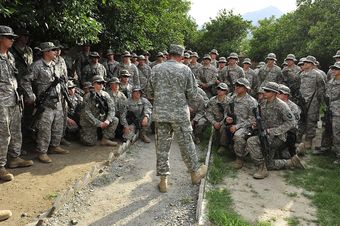
Group Leadership
General Petraeus talks with U.S. soldiers serving in Afghanistan.
Group Leadership
Communication is one of the most important aspects of working successfully in a group setting. Therefore, good communication skills are an essential quality for a good leader. Communicating is always difficult in a group, but these difficulties can be magnified by factors such as large group sizes, strong personalities, or differences in opinion.
When working in a group, it is important to have a common goal around which group members can unite. This is something on which all group members can agree and which they all desire to work toward. When leaders find that they have particularly strong-willed group members who seem to dominate the conversations, or several group members who do not seem to get along, communication can often be the key to resolving the conflict.
In these situations, effective communication techniques include discussing the conflict openly with the members involved, providing a more structured discussion forum so all members can be heard, or even engaging group members in non-project related bonding activities such as ice-breaking games, a group lunch, or a fun outing.
Technology is now a great resource for effective group communication. Technology is a great way for large groups to share their ideas. Often, groups can become so large that it is difficult for all the members to meet at the same time and place. Additionally, in large groups it can be difficult to allow everyone’s ideas to be heard. Through various platforms such as email, Google Groups, Blackboard, Facebook, and others, it is possible for group members to share their ideas in an organized manner so they can be read by others at their own leisure.
While leadership styles may vary with person and situation, it is always important for leaders to remember their role in the group. Effective leaders both participate in the group and work to achieve the overall goal of the group, guiding members in the right direction. Effective leaders will build mutually respectful relationships with their group members. Having a rapport with group members allows leaders to better understand members’ actions and increase their cooperation. Finally, effective leaders facilitate excellent communication amongst the group. Great communication leads to better and more effective idea generation and less conflict overall.
18.1.2: Responsibilities in Group Work
When all member assume their expected responsibilities, working in groups can be enjoyable and effective.
Learning Objective
Describe the typical roles and responsibilities of group members
Key Points
- Assigning group members roles can help alleviate uncertainty about expected responsibilities and help keep the group on task such as leader, scribe, devil’s advocate, and tracking lessons learned.
- Group member responsibilities include holding themselves accountable, participating in group activities to achieve the overall goal, and respecting all members of the group.
- Each group member has something uniquely valuable to bring to the table. Allowing group members to use their strengths and bring their individual knowledge and backgrounds to the project will allow the group to function to its full potential.
Key Term
- group think
-
A process of reasoning or decision – making by a group, especially one characterized by uncritical acceptance or conformity to a perceived majority view.
Responsibilities in Group Work
When participating in group work, every member of the team has a responsibility to the group and the project. If each member does not participate, contribute, and deliver results, the group will ultimately fail to achieve their goal. Collaboration becomes effective only when group member participation is balanced .
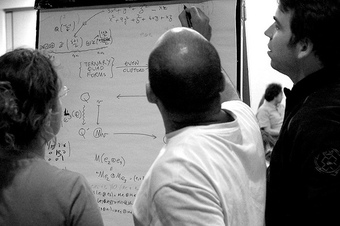
Group Work
Assigning roles can make groups more effective.
Everyone in a group must learn to hold themselves accountable and be accountable to the other people in their group. Without accountability, work will not get done, deadlines will not be met, and the group will not be able to reach its goal. Individual and group accountability means that no one student has to do all the work. Accountability means not only being accountable for the physical work that a group member must deliver, but also attendance to group meetings, conduct, and behavior towards other group members, etc. It is also important to remember that group members are diverse and each one has a different strength and perspective to bring to the project based on their backgrounds, learning style, experiences, and aspirations.
Typical Roles in a Group
While everyone should be responsible for brain storming, problem solving, and providing their experience and knowledge, sometimes it can be helpful to assign group member specific roles. That way, members know exactly what they are responsible for. Four roles that are commonly found in groups are: a leader, a scribe, a lessons learned tracker, and a devil’s advocate.
- Leader – In the event there is no clear chain of command, a team must be prepared to assign the role of leader. A leader can keep the team focused, mediate conflicts, and ensure that individuals are held accountable.
- Note taker or scribe – again, a simple idea, but documenting every meeting is an important step in developing a productive team. A scribe can quickly get a team up to date with past notes so little time is wasted remembering where you left off. Documenting and distributing notes from each meeting will equally inform all team members.
- Lessons Learned tracker – Identify one person to track both positive and negative outcomes of meetings and projects. This individual can solicit input from other members. By documenting what everyone thinks went well and why and what did not go well and why, can keep a team productive by not repeating past mistakes.
- Devil’s Advocate – Teams need to embrace conflict and different points of view. By assigning a devil’s advocate, this person can freely bring up alternatives or objections, making the team more objective.
By assigning these roles to members of the group, it can increase efficiency and productivity. The group now has people in specific roles to help them stay on track and the group members can now clearly outline their responsibilities in regards to the group work.
Characteristics of Great Group Members
Characteristics of great group members are those who actively participate, respect all other members, can both learn from other members and teach them, values other’s contributions, draws on their own unique past experience and knowledge, and feels a sense of ownership over the project. To strive to embody all of these characteristics is the responsibility of all group members, regardless of their assigned role.
Responsibilities of Group Members
Group members are not only responsible for creating positive productivity within their group, but they must also avoid falling into the trap of unproductive behaviors that also arise in group settings. Group think and social loafing are two incredibly common negative phenomena that arise in group collaboration.
- Groupthink is simply going along with the team on a decision because that seems to be the consensus and they want to avoid conflict. Having a strong devil’s advocate will help reduce the chances of groupthink.
- Social loafing is someone that is putting forth less effort as a member of a group than they would as an individual. They are allowing the other members of the group to do the majority of the work with the intention of still reaping equal benefits. Again, leadership and holding people accountable is a great tool to deal with social loafing.
Working in groups can be challenging. Blending people from many different backgrounds, with different personalities styles and work ethics can make consensus difficult. However, when all group members take on their expected responsibilities, group work can become much more enjoyable and effective.
18.1.3: Reflective Thinking
Reflective thinking about group work allows students to evaluate both successes and failures of the project and work towards improvement.
Learning Objective
Explain how reflective thinking is used in group settings
Key Points
- Reflective thinking requires scientific analysis of a problem and using empirical knowledge to make decisions.
- According to John Dewey, a disciplined mind is necessary to gain knowledge and obtain true intellectual freedom.
- When group members use reflective thinking, they are able to use the scientific method to reach logical decisions and understand the strength of the group based on individual competencies.
Key Term
- scientific method
-
A method of discovering knowledge about the natural world based in making falsifiable predictions (hypotheses), testing them empirically, and developing peer-reviewed theories that best explain the known data.
Reflective Thinking
Reflective thinking is using the scientific method to make a decision. This helps to create deep learning, which will enable the growth of an individual in many different aspects, including morally, emotionally, and cognitively. Reflective thinking helps to determine an individual’s strengths and weaknesses by allowing individuals to question values and beliefs, challenge assumptions, recognize biases, acknowledge fears, and find areas of improvement.
John Dewey and Critical Thinking
Dewey’s method of critical thinking involves a disciplined mind in order to gain knowledge . A disciplined mind needs intellectual control of the thinking process, which is so often emotionally based. This disciplined mind offers intellectual freedom, and discipline shouldn’t be viewed as a negative aspect as many individuals believe it to be.
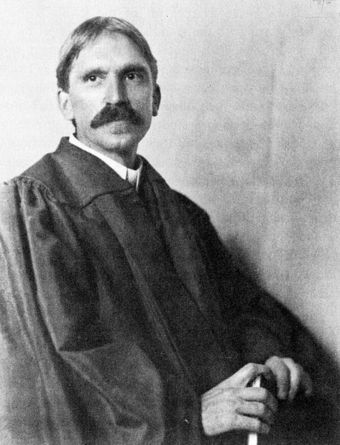
John Dewey
Public speaking students are often taught John Dewey’s methods of reflective thinking.
Reflective Thinking in a Group Setting
Using reflective thinking in a group setting can allow for intellectual decisions based on defining a problem and using concepts based in logic to select the best solution. Group members will then be able to compare and contrast their colleagues’ interpretations of the project experience with their own. They can learn about the strengths and weaknesses of the group, as it is comprised of the competencies and assumptions of the individuals.
Reflective thinking about group work should cover ideas such as:
- What did I do well? What did the group do well?
- What could I improve on? What could the group improve on?
- What was one of the largest obstacles the group faced? Did did we overcome it? How?
- Was there group conflict? Was it resolved? How?
- Was our group successful? Did we complete our objective? Why or why not?
- What would we do differently if we were given the opportunity to repeat the project?
Reflective thinking is an excellent tool for identifying positive and negative aspects of a group work experience. By spending time seriously contemplating the overall process, both during and after the project, it is possible for group members to learn from their experience and work toward improving their group work skills for the future.
18.2: Presenting Group Thinking
18.2.1: Group Presentation Formats
Group presentations can be structured around a set format or can borrow components from different formats.
Learning Objective
Define four formats of group presentations
Key Points
- A panel format is a discussion between group members led by a moderator.
- A divided presentation is a sequence of individual presentations by group members.
- A debate format presents two sides of an issue and reasons for and against each side.
Key Terms
- forum
-
A form of discussion involving a panel of presenters and often participation by members of the audience.
- symposium
-
A conference or other meeting for discussion of a topic, especially one in which the participants make presentations.
- format
-
The form of presentation of something.
Group presentations can take place in different formats. These formats give a group an idea of how to structure their presentation, though different components can be taken from several formats and combined according to a group’s particular needs and goals.
Panel Presentation
A panel is a format in which the presenters talk to each other in addition to the audience. Typically the panel will consist of several group members to whom a moderator poses questions. The panel members then present their views on the question and discuss their different answers. The audience has the benefit of viewing this dynamic discussion play out before them. Often questions will also be taken from the audience, so audience members can become involved in the discussion as well. However, with such loose organization, the moderator must maintain control over the presentation and keep the group on topic .
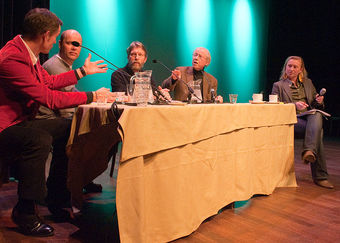
Panel Discussion
In an panel discussion, the panel members talk to one another as well as the audience.
Symposium
A symposium presentation is a group presentation that is essentially a collection of individual presentations covering a broad topic. The topic is broken up into subtopics, and each group member, one after another, makes a presentation on his or her subtopic. All together, the group covers the topic in its entirety. This format is very easy to organize and coordinate as long as each group member remains cognizant of not addressing a different member’s subtopic. Since this method can make for a long presentation, the group members must concentrate on engaging the audience and keeping their attention.
Public Forum
Public forum debate can be compared to a nationally-televised debate, such as ‘Crossfire’ in which the debaters argue a topic. The debate in a public forum is conducted by teams of two people alternating speeches for their side, either affirming or negating their topic. Successful public forum debaters must make persuasive and logical arguments in a manner that is accessible to a wide variety of audiences. Public forum debate also focuses on not only logical, but research based arguments.
Oral Report by Group Leader
In this format, the designated leader of a group makes an individual presentation of the group’s thoughts and findings on a topic. The leader may summarize views from several different group members and present points of agreement and disagreement.
18.2.2: Thoughts for Group and Individual Presenters
Each individual in a group presentation should know their role and stay consistent and cooperative with the other members.
Learning Objective
Demonstrate how to each individual in a group should participate in a group presentation
Key Points
- The first speaker should introduce the entire presentation. After that, each speaker should introduce the next and transition with a preview of their topic.
- Each presenter should make eye contact with the audience and move to the front of the group when it is his or her turn to speak. The last speaker should then conclude the entire presentation.
- When preparing the presentation, the group should check each individual’s work for consistency of information and formatting. Group members should answer audience questions as a team with no one member dominating.
Key Terms
- transition
-
The process of change from one form, state, style, or place to another.
- consistency
-
correspondence or compatibility
There are several important considerations for an individual to keep in mind to help a group presentation succeed.
Choosing Roles
The instructor may require every person to speak during the presentation. However, if you are given a choice of how many speakers to include, decide which group members will speak and which ones will not. Because it is important for every student to develop strong knowledge of presenting, every member could benefit from speaking. Any members who do not present should be given other significant responsibilities .
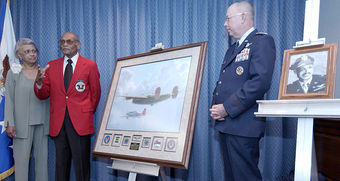
Group Presentation
In a group presentation, all of the members will have a specific role.
Group Introduction
The first speaker should open with an introduction to the whole presentation rather than an introduction to only his or her part. This group introduction makes the presentation as a whole accessible to the audience. It introduces the group members, establishes goodwill between speakers and the audience, motivates them to listen, and previews all the talks.
Transitions between Speakers
Each speaker should identify the next speaker by name and signal that person’s topic. Changing speakers without such a spoken transition can break the flow of the presentation, and it may leave the impression that you are unprepared or that your presentation is unorganized. A transition should remind the audience of the sequence the group introduction promised. It should help listeners know where they are in the presentation as a whole. Transitions may also emphasize any special qualifications of the next speaker.
Internal Previews
Each individual speaker except the first should connect his or her part to the overall argument and tell the audience what topics he or she will discuss. Such statements identify the structure of the talk and help the audience follow along.
Group Conclusion
The last speaker should present a conclusion for the whole presentation rather than just a conclusion for his or her part. The last speaker is responsible for ensuring that the series of talks is comprehensible as a whole. He or she should summarize briefly the key points, motivate the audience to act, or reinforce the group’s interpretation of the issue with a memorable closing statement.
Move to the Front to Speak
If all the group members remain standing during the presentation, each one should move to the front of the room when it is his or her time to speak. Moving to the front will non-verbally draw the audience’s attention to the speaker.
Connect with the Audience through Eye Contact
In a team presentation, every individual speaker needs to develop rapport with the audience. Since each person has only a short time to connect with the audience, eye contact and introductions are especially important. Speakers should stand where they can see the computer screen, the audience, and, if possible, other team members.
Check for Overlaps, Accuracy, and Consistency
Since group members often prepare their parts of the presentation individually, it is necessary to check for overlapping or contradictory information once the individual parts are assembled. Although the first and last speakers cover the presentation as a whole, the speakers in the middle should not re-present evidence unless new analysis is involved. A speaker should build on what the previous speaker said—not merely repeat it.
Check for Consistent Formatting
All handouts or visuals should use the same formatting. A patchwork of different fonts, font sizes, and other formatting conventions may negatively impress the audience, distract or mislead them, and undermine the group’s credibility.
Answering Questions as a Team
The person who speaks first should act as the leader during Q&A. He or she should direct questions to the team member who knows most about the topic of the question and should therefore answer first. The leader should not dominate Q&A. Other team members may unobtrusively signal that they would like to contribute to the answer when the first person finishes.
18.2.3: Preparing for Team Presentations
The way a team functions while preparing for a presentation can be broken down into formal processes and interactions.
Learning Objective
Define the processes that describe the dynamics of group thinking and team presentations
Key Points
- The model for understanding team processes can be grouped into three categories: transition, action, and interpersonal.
- Teamwork processes examine interpersonal interactions between group members, which can be used as strategies for successful presentations.
- Another approach to the dynamics of a team presentation involves looking specifically at the strategies that guide interactions between group members throughout the team effort.
- Establishing ground rules, coordinating meeting times, and effectively resolving disputes are some methods used to build effective teams and group presentations.
Key Terms
- process
-
A series of events to produce a result, especially as contrasted to product.
- strategy
-
A plan of action intended to accomplish a specific goal.
Preparing for Team Presentations
The way a team prepares for a presentation can be broken down into formal processes and interactions. This is not a strict distinction, but two different ways of analyzing how a team achieves its goals while building, practicing, and delivering a presentation.
Processes
Researchers have identified ten teamwork processes divided into three categories, which can be used to describe the dynamics of group thinking and team presentations.
Transition processes are reflective in nature, and take place between periods of action. They serve to assess previous actions and outline future actions. In team and group presentations, these processes can serve to:
- Determine what the team is trying to achieve, and what steps will lead there.
- Specify the incremental goals and accomplishments that will lead to overall mission success.
- Formulate an approach to achieving the goals and mission.
Action processes embody the steps that the group takes to move forward. Whether during preparation or delivery of a presentation, these actions are crucial to working effectively in a team. Team members within groups must:
- Monitor progress toward goals and make sure the team is on track, rather than veering off course.
- Assure that roles and responsibilities are being fulfilled.
- Monitor and backup behavior to ensure that all members remain engaged.
- Coordinate roles to keep things organized and working smoothly.
Interpersonal processes apply during the delivery of group presentations, while team member both present and transition between roles (e.g., speaker and observer). They include:
- Identifying and resolving disputes.
- Motivating and building confidence, while maintaining high member performance.
- Making sure group member participation steers rather than stalls the development and delivery of the presentation.
Interactions
Another approach to the dynamics of a team presentation involves looking specifically at the strategies that guide interactions between group members throughout the team effort. Examples of strategies for interaction include:

Group Interactions
Timing transitions between slides and other breaks is crucial to a well-prepared group presentation.
- Establishing ground rules: Establishing ground rules sets expectations for each group member on how the group plans to achieve its end goal (e.g, educate students, sell a product to prospects, etc). Making these rules explicit helps avoid miscommunication at the beginning of the project.
- Mission analysis:This strategy ensures every team member has contact information for the others, and that everyone’s schedule is coordinated for meeting times. At a higher level, it means achieving consensus on how group decisions will be made and how group information will be shared with all team members.
- Managing team cooperation: This strategy applies to group meetings. It focuses on outlining an intention for each meeting, and reviewing meeting activities and actions to ensure the intention has been met.
- Resolving conflict: Resolving conflict requires the group to acknowledge that there is a legitimate conflict. The group must then agree on an approach to address it, and determine how to proceed. Possible solutions include discussing a compromise, referring to previously established group decisions, or deciding to address the issue later.
- Preparing Back-ups: Practicing transitions between group members’ sections, preparing extra copies of handouts and other visual aids, and reviewing group members’ roles are all part of this strategy. This helps improve preparation and the delegation of tasks within the group.
